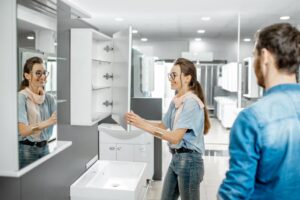Today, virtually all of your shoppers start their buying journey online. This is especially true in a COVID-19 marketplace where states shuttered retail establishments and consumers are leery to visit stores. Customers are browsing sites like Pinterest for inspiration and store websites for available options. Before they even decide to head to your store, they’ve finalized most of their selection process.
More than ever, shoppers skip the showroom visit altogether. The increased use of communications channels like FaceTime, Zoom and onsite chat during quarantine made shoppers more comfortable buying big-ticket items online—even houses—without ever physically experiencing them.
This shift in the buyer’s journey is having a major impact on the role of your sales associates. It can be a positive change, but only if you implement these three changes right away.
1. Meet Customers Where They Are
Since shoppers are starting the purchase process online, sales associates must be there, too, with tools that enable them to effectively sell in the digital channel. Sales associates can engage with shoppers, helping them feel comfortable purchasing and discover more items.
Forming a relationship early in the process a major advantage. As the sales associates gains more context about a buyer’s needs, they can address the broader goal instead of facilitating the sale of a single item. Consider it to be the difference between selling a customer a dining room table and helping them furnish their entire dining room.
2. Facilitate “In-Home” Consultations
Shoppers still need human assistance to ask questions and finalize those buying decisions. They want to know details that aren’t easily conveyed online, such as the softness of a bed or the feel of a fabric. And, they’re inviting sales associates into their homes during the process, simulating more of a design consultation.
In-home consultations are proven to lead to larger transactions. However, designers usually perform this type of service—and most sales associates are not designers. Capitalize on this by enabling associates with the tools they need to provide designer-like advice, helping shoppers furnish rooms in a way that creates a better process and customer experience.
3. Change Their Role to Ambassador
Just as in the past, sales associates must have a strong expertise on your product as well as deep knowledge of your promotions and financing. But now they must also serve as “ambassadors,” co-shopping with customers and interacting throughout the sale versus selling to the shopper.
To be effective, your associates must be able to see the products that interest the shopper and understand the shopper’s goals and preferences. They need to encourage discovery with inspiration they put together real time, and allow the shopper to react and provide input collaboratively throughout the process. Sharable inspiration boards on your site are a great proxy for the physical mood board, especially if they allow the shopper to finalize the basket and complete the purchase directly.
How It’s Done
To effectively change the role of your sales associate, your website needs technology that meets the consumer where they are. Shoppers will want service on demand and they will not always want to schedule an appointment. Staffing a virtual assistance desk with digitally adept and properly enabled sales associates on call would help.
The interactions between customers and sales associate must be an ongoing conversation and not an ad hoc request. This means the digital interactions must be accessible from the store and visa-versa. To the extent the shopper must work with different sales associates through the process, this will provide the seamless experience the shopper requires. You will likely need to train and reskill associates and enhance your hiring criteria going forward.
Finally, you must incentivize associates for sales in any channel, compensating them for digital sales in the same way they are in store. These steps can increase the transaction size, and your associates are a vital part of the process.
Shoptelligence Can Help
Virtual selling offers some unique benefits over in-store selling. The breadth of products customers will consider purchasing from that retailer is almost certainly complete before they set foot in the store, evidenced by the now doubled in-store conversion rates retailers are experiencing today. The trick is to maximize the size of that consideration set online so in store and online purchases are bigger. Virtual sales consultations with a bend toward product discovery are a critical way to achieve this.
Shoptelligence is proven to help shoppers engage with 50% more product categories and buy 32% more by providing shoppers a designer-like experience. The Virtual Sales Assistant capability helps sales associates access shopper browsing history, customize ensembles and share inspirations with shoppers to get them to purchase more anywhere. Easily integrated with chat and other virtual collaboration tools, associates can virtually serve any shopper. Discover how Shoptelligence can help your associates co-shop with consumers to engage them in every stage by scheduling a demo today.






